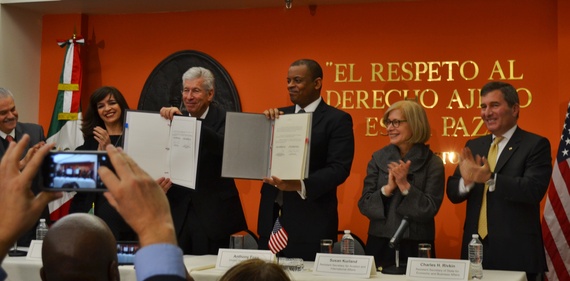
This post is drawn from Assistant Secretary Charles Rivkin's remarks at the signing of the U.S.-Mexico Air Transport Agreement at the Embassy of Mexico in Washington DC on December 18, 2015.
With this new, modernized air transport agreement between the U.S. and Mexico, we affirm a vision of international aviation that we have long known to be true. When governments step aside and let air carriers decide where to fly and what aircraft to use based on the demands of the market, then everyone wins. We have seen that to be the case around the world. And I cannot think of anywhere where this would be more evident than in our important relationship with Mexico.
As a former businessman who worked in Southern California for 20 years, I know firsthand how deep the economic and cultural ties are between our countries. Just look at the numbers. We exchange more than $1.5 billion in goods and services daily, supporting millions of jobs in both countries. The United States exports more to Mexico than to Brazil, Russia, India, and China combined. Our businesses and workers count on each other to help fuel our economies.
And this agreement will only bring us closer together. When it enters into force, the agreement will dramatically expand opportunities for travel and trade between our two nations. This will mean more high-quality jobs and greater economic growth on both sides of the border.
For our air carriers, the agreement will open our airways to greater competition by removing government-imposed restrictions. Up until now, routes between the U.S. and Mexico have only been open to a limited number of air carriers. Today, we're changing that.
And our airlines won't be the only ones to benefit from this agreement. Travelers and businesses on both sides of the border will have more and better choices when planning travel or shipping their goods. And more competition encourages airlines to offer lower airfares and more convenient flights.
By paving the way for greater connectivity, this agreement can also be an engine for high-quality job growth in industries beyond aviation. For example, tourism and hospitality stand to benefit, as communities across both countries will welcome more visitors.
Manufacturers and shippers will be able to move goods more efficiently and cheaply, increasing the competitiveness of Mexican and U.S. products in the global marketplace. And cargo carriers from both countries will have new opportunities under this agreement to connect to better global networks.
As Assistant Secretary of State for Economic and Business Affairs, it's a pleasure to have a role in cementing such a significant agreement, and realizing a milestone under the U.S.-Mexico High-Level Economic Dialogue. This was a major team effort. This agreement is the result of more than two years of negotiations and represents the hard work and outstanding collaboration of both governments, including our team from the Department of State working with the Department of Transportation and Department of Commerce, and their colleagues on the Mexican side.
I hope we see the agreement enter into force as soon as possible, so that we can begin this new chapter in commercial aviation between the United States and Mexico.
